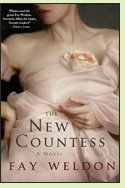The New Countess
by Fay Weldon
Reviewed by Margaret Tomlinson

Last in the "Habits of the House" trilogy, The New Countess takes its cast of aristocrats, born or married-into-the-manor, and their servants through the one-year period from June 22, 1905, to June 22, 1906. It's an eventful time. The sweet American bride begins to question whether she can be happy with a viscount more passionate about his motorcar manufacturing business than about her, especially when he and her mother-in-law insist on their children being raised by a senile and domineering nanny. The viscount's feminist sister returns from Australia and outrages sensibilities with her plans to publish a scholarly tome about Aboriginal sex practices. Most eventful of all, the viscount's father casually invites "Bertie" - King Edward VII - and his mistress to a shooting party at their country estate, plunging the viscount's mother into a fever of worry and expensive redecorating.
A cross between a soap opera and a comedy of manners, The New Countess zips along without plumbing its characters' psyches too deeply or getting readers too emotionally involved with any one character - though one can't help but feel for the children trapped in the charge of their heartless nanny. An interesting character from history is Edward VII's companion Alice Keppel, who appears only briefly in person, though in some ways she is the novel's central character.
Weldon has written over thirty novels. In the reading-group end notes for the edition I read, she outlines her formula. For example: "I unabashedly use archetypes for characters.... But every time they turn up in the story, I make them a little more complex: they will think or feel or do something out of turn, or unexpected, and so they can end up rounded and believable ..." The formula makes this novel a brisk, easy read. (2013, 327 pages)
More about The New Countess at Powell's Books or Amazon.comOther novels set in Edwardian England:
A Bloom in Winter by T.J. Brown (2013), about three sisters in 1914 who strive, each in her own way, to escape the confining and undemocratic traditions of Edwardian England; #2 in the Summerset Abbey trilogy. See review or more info at Powell's Books
The Dream Kingdom by Cynthia Harrod-Eagles (2003), a family saga set in 1908 England; #26 in the Morland Dynasty series. More info
Falling Angels by Tracy Chevalier (2001), about two London families of different social classes whose daughters meet at a cemetery and become friends. See review or more info at Powell's Books
Nonfiction about Edward VII and Alice Keppel:
Edward VII's Last Loves: Alice Keppel and Agnes Keyser by Raymond Lamont-Brown (1998). More info
Mrs. Keppel and her Daughter by Diana Souhami (1996). More info
Edward VII: The Last Victorian King by Christopher Hibbert (2007). More info
At the Movies:
Downton Abbey
Online:
Alice Keppel at Wikipedia
Back to Nineteenth-Century Europe
Back to Directory of Book Reviews